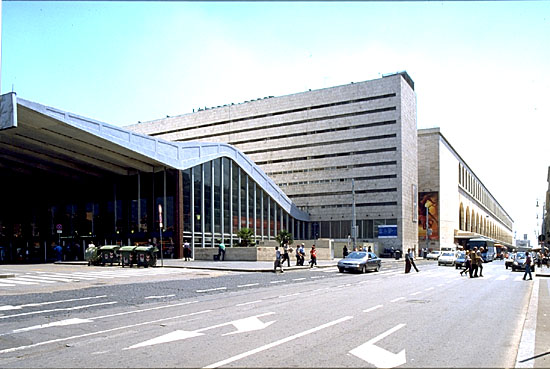-Aldo Rossi, Architecture of the City
History and Background:
The Esquilino hill, one of the
In 1863, Pope Pius IX opened the first termini station on the site of villa Montalto-Peretti , the station was constructed in 1868 and completed in 1874, based on the design by Salvatore Bianchiby. In 1937, in preparation for the planed 1942 world fair in
The insertion of this piece of monumental infrastructure has stimulated much turbulence and change in the Esquilino neighborhood. Being
Lesson of Esquilino “Degradation”:
- The imposing modernity
Modernity flourished after the industrial revolution and rise of the machine age. Modern architecture favors styles that simplify forms and eliminate ornament. Form follows function. These shifts in aesthetics and paradigm result in the production of an urban landscape with imposing monuments of machines.
The above image of the Termini imposing itself over the off-scale neighborhood has a curious resemblance to the photomontages of the “continuous monument” of Superstudio, In this project, the architects expressed concerns over the possible future when modern technology and culture renders the world uniform with a single continuous environment. Every point in the built world would be identical and neutral, without a distinct identity. The modern obsession with speed and efficiency has created the new orthodox of converting the historic city center into glorified railway intersection. The monotony and length of this modern machine of efficient transportation isolates itself from the continuous and richly composed Roman cityscape, hence generating a locus around it also detached from the urban landscape which follows its own modern development.
- The Paradox of futurism and tradition
In Piranesi’s etching “caceri d’invenzione” depicting an imaginary prison interior, he conveys an important idea: irrational and rational are no longer mutually exclusive. The problem of resolving equilibrium of opposites is fundamental to the concept of architecture.
In the
At Termini station, the continuous strip windows and dynamic structural lines expressing the Futurist idea of speed and streamlining, juxtaposed with the ancient Servian wall in front of the building façade, conveys a similar idea. The radical future adjacent to the ancient past, this collision is an apt manifestation of time and change in architecture. The dramatic contrast between the modernistic, even futuristic train station and the historic urban fabric creates a tension which disjoins the Termini affiliated area with the rest of the city, making it an isolated locus.
-The ambiguity of identity

The Greek-Italian surrealist painter Giorgio de Chirico was famous for his metaphysical depictions of Italian cities. These imagery often included long porticos and colonnades, solitary monuments and figures, dramatically cast shadows and contrasting classical architecture with a new model of monumentality of the industrial age. They convey a suspended temporality, a blaze outlook prevalent in modern cities with nostalgia for the past in memory.
The two-kilometer long side structure of the design by Angiolo Mazzoni remains part of the current-day station. The parallel between this modern side façade clad in stone and glass and a roman aqueduct raise the question about the identity of this architecture. Is it modern or inherently archaic?
The ambiguity of the monumental architecture also blurs the identity of the neighborhood. Is it ancient or modern? Is it Roman or international? All people have a human desire to retain unique identity. A person’s past fulfills some inherent notion of a person’s individuality. When the monument of the locus does not provide a strong identity for the context, people define themselves by their past and memories. The Romans left for a traditional cityscape they identify with, while the immigrants settle for the multi- faceted modernity in the locus solus.
Within the Locus Solus:
Today, immigration has been the driving force behind the transformation of Esquilino. With the influx of immigrants from Asia, Africa, the Balkans and
work cited:
Architecture of the City: Aldo Rossi
Toward an Architecture: Le Corbusier
Rossi’s Poetics of the Fragment: The Physical (the City) and the Temporal (Memory)
http://www.limacon-design.com/Rossi_Poetics.pdf
http://www.surrealismcentre.ac.uk/papersofsurrealism/journal2/acrobat_files/cardinal_article.pdf









No comments:
Post a Comment